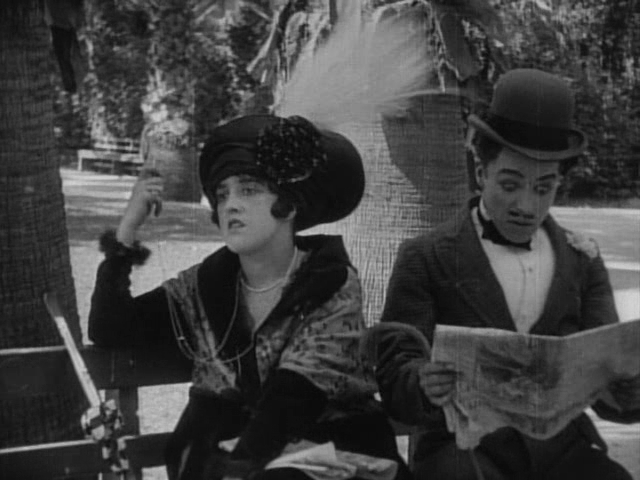“The death of Mr. Banks leaves his niece Tillie the sole heir.”
|

Synopsis:
A con-artist (Charlie Chaplin) convinces a farmer’s daughter (Marie Dressler) to elope with him to the city after stealing her father’s stash of money. Once there, he quickly takes up with his former flame (Mabel Normand), but shifts his allegiances once again when he hears that Tillie (Dressler) has inherited a million dollars from her deceased uncle.
|
|
Genres, Themes, Actors, and Directors:
- Charlie Chaplin Films
- Comedy
- Con-Artists
- Inheritance
- Marie Dressler Films
Review:
Directed by Mack Sennett, this early Charlie Chaplin/Marie Dressler vehicle is notable as the first feature-length comedy film, and as such will be of at least passing interest to film fanatics. Unfortunately, the movie itself is little more than an extended slapstick scenario, with Chaplin’s “Little Punk” doing whatever it takes to milk poor Dressler of her familial funds, overweight Dressler mugging like crazy for the camera, and Mabel Normand having fun playing Chaplin’s no-good sidekick (watch for an interesting scene in which she and Chaplin watch a silent film about cons like themselves). Given that Peary doesn’t list short films in his book, it’s a bonus as well to see the Keystone Kops showing up near the end of the story; regardless of how much one actually enjoys their antics, film fanatics should at least be familiar with their schtick.
Redeeming Qualities and Moments:
- An early glimpse at several silent screen icons


Must See?
Yes, but simply for its historical importance as the first feature-length comedy. Available for free viewing at www.archive.org.
Categories
Links:
|
One thought on “Tillie’s Punctured Romance (1914)”
First viewing. A once-must, for its place in cinema history – and for Dressler and Chaplin’s performances.
Keep the following in mind:
a) I am not a huge fan of silent films overall, as I’ve written elsewhere at this site. Of course, there are some that I love that I also think have stood the test of time. But the bulk of them can be trying for one reason or another – even for film fanatics.
b) As I’ve also written elsewhere here – if I have to choose between Chaplin and Keaton, I’ll always take Keaton, since most of his films still work quite well today and I just happen to find them funnier. Chaplin has, of course, done some fine work – but, too often, I find he had a tendency to push or milk for sentiment.
c) I tend to dislike slapstick, esp. for its own sake. Much of it is just people getting hurt, which I don’t find funny.
Considering all that, it may be surprising that I loved this film. For a silent film, esp. this early a silent, it remains exceedingly strong and vastly entertaining. It also comes with a bare minimum of titles attached (and even some of the ones used are unnecessary). What’s astonishing about that is the fact that the cast succeeds so well in communicating the story that they don’t even need dialogue!
Not that it’s that hard a story – it isn’t. Still, it’s impressive watching a plot unveil mostly through visuals.
Chaplin is rather effective here – and it’s perhaps significant that he did not direct himself in this film, so he had a watchful eye curbing self-indulgence. As well, he’s playing against type: he’s playing a terrible person, so he’s not allowed the kind of sympathy extended to him in his own films. Of course, his performance is not without some of the typical Chaplin antics – but he’s stretching himself here as an actor, and that’s refreshing to watch.
As for the slapstick…well, there’s no way of making slapstick subtle, but it apparently can be made to be…different. Up until the free-for-all that the film builds to, most of the slapstick (and there is a lot of it) comes more directly from Chaplin and Dressler’s *characters*, as opposed to the situations they’re in. That difference may be lost on some – some may say that slapstick is slapstick, no matter what…and I might normally agree; but I think this film brings an exception.
~which brings us to Dressler, who dominates this film blissfully. Hers is a tour-de-force turn. If Dressler is known to film fanatics at all, that is mostly (perhaps) due to her small role in ‘Dinner at Eight’ (“Reading a book?!”, she asks, in shock, of Jean Harlow) or her supporting role in ‘Anna Christie’ (1930), which could be that film’s saving grace.
But, here, Dressler reveals herself as a supreme comedienne. What she does may, in some way, be seen as ‘mugging’ but I don’t see it that way. Dressler’s Tillie is a very specific character and Dressler’s comic choices (and there are tons of them) fall completely in line with that.
Tillie, for some reason, seems to have it in her mind that she is something of a petite coquette – and that gives Dressler her through-line for the film. (That line is not without a break: when Tillie becomes heir to a fortune, she suspends her girlishness long enough to suspect that she’s being taken for a ride. Still, that thought passes and she returns to naive form.)
I love the way the script progresses. It’s very mildly complex yet simple in its logic, and it comes full-circle.
Although I had anticipated that this film would be a slight chore to get through, I found it to be quite the opposite. It’s a fun romp indeed…and a triumph for Chaplin and Dressler.
NOTE: At the wedding celebration near the end of the film, there is the brief appearance of a gay character – the ‘sissy’ type, who makes a fuss of Dressler and Chaplin (and who Chaplin finds disturbing).